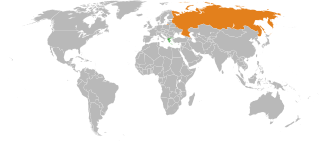In diplomacy, a persona non grata is a status sometimes applied by a host country to foreign diplomats to remove their protection by diplomatic immunity from arrest and other normal kinds of prosecution.

Vitaly Ivanovich Churkin was a Russian diplomat and former child actor. Churkin served as Russia's Permanent Representative to the United Nations from 2006 until his death in 2017.

The Embassy of Russia in Washington, D.C. is the diplomatic mission of the Russian Federation to the United States. The chancery is located at 2650 Wisconsin Avenue, Northwest, Washington, D.C. The embassy oversees consulates in New York and Houston.

Greece–Russia relations refers to the bilateral relationship between Greece and Russia and their predecessor states. Diplomatic relations between the Russian Empire and the Greek state were established in September 1828. Both Greece and Russia are full members of some international organizations, including the Council of Europe, the Organization for Security and Co-operation in Europe and the Organization of the Black Sea Economic Cooperation. Despite Greece being member of NATO and the European Union, their relationship has been notably strong.

The Russian Federation and the Kingdom of Spain, a member state of the European Union, have bilateral foreign relations. Spain and the Grand Duchy of Moscow first exchanged envoys in 1520s; regular embassies were established in 1722. Soviet-Spanish relations, once terminated after the Spanish Civil War, were gradually reestablished starting in 1963 and were fully established by 1977. Trade between the two countries amounted to two billion Euros in 2008. In March 2009, the two countries signed an energy agreement providing national energy companies access to other party's domestic markets.

Czech Republic–Russia relations are the bilateral foreign relations between the Czech Republic and the Russian Federation. Unlike Russia, the Czech Republic is a member of Western institutions including the European Union, NATO and the OECD. Relations have substantially deteriorated in recent years due to events such as the Russian annexation of Crimea in 2014 and the poisoning of Sergei Skripal in 2018.

Latvia–Russia relations is the bilateral foreign relations between Latvia and Russia. Latvia has an embassy in Moscow and two consulates general: in Pskov and Saint Petersburg. Russia has an embassy in Riga and two consulates general: in Daugavpils and Liepāja.

The Embassy of the United States of America in Moscow is the diplomatic mission of the United States of America in the Russian Federation. The current embassy compound is in the Presnensky District of Moscow. Its New Office Building (NOB) address is: Bolshoy Deviatinsky Pereulok No. 8. The NOB was opened on May 5, 2000. From 1934 to 1953 the embassy was located in the Mokhovaya House, 13 Mokhovaya Street, near the Kremlin. In 1953 the embassy moved into the Existing Office Building (EOB) on Novinskiy Boulevard, which still remains a part of the embassy compound.

Sergey Ivanovich Kislyak is a Russian senior diplomat and politician. Since September 2017, he has represented Mordovia in the Federation Council, the upper chamber of the Russian legislature. Previously he served as the Ambassador of Russia to the United States from 2008 to 2017. From 2003 to 2008, he was the Deputy Minister of Foreign Affairs, and from 1998 to 2003, he served as the Ambassador of Russia to Belgium and Russia's Head of Mission to NATO.

The Russian Cultural Center is a museum and building in Washington, D.C., supporting Russian culture in the United States and preserving its causes and beliefs. It calls itself, "the official home of Russian culture in the United States," and hosts public events featuring visiting Russian musicians and artists to foster better relations and understanding between the U.S. and Russia. The center is operated by Rossotrudnichestvo, an autonomous agency of the Russian Foreign Ministry.

The Consulate-General of Russia in New York City is the diplomatic mission of the Russian Federation in New York City. Opened in 1994, the consulate is located at 9 East 91st Street in the former John Henry Hammond House in the Upper East Side of Manhattan. A consulate of the former Soviet Union had previously existed on East 61st Street from 1933 until 1948.

The Diplomatic Service of the Republic of Lithuania is the part of the governmental service tasked with enforcing the foreign policy set by the President, the Parliament, and the Government of the Republic of Lithuania. The head of the service is the Foreign Minister.

The Kasenkina Case (Russian: "Дело Касенкиной") – the 1948 Cold War political scandal was associated with the name of Oksana Kasenkina, a teacher of chemistry at the Soviet school in New York.

Jacob Mironovich Lomakin was a Soviet diplomat, journalist and economist.

The Consulate-General of the People's Republic of China in Houston was a diplomatic mission of China, headquartered at 3417 Montrose Boulevard in the Montrose neighborhood of Houston, Texas. It served eight states in the Southern United States: Texas, Oklahoma, Louisiana, Arkansas, Mississippi, Alabama, Georgia, and Florida, in addition to Puerto Rico. An earlier diplomatic mission had been established by the Republic of China government and was in existence by 1935.
















